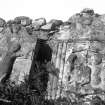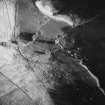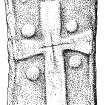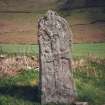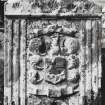Camas Nan Geall, Cladh Chiarain
Burial Ground (18th Century), Gravestone(S) (18th Century)
Site Name Camas Nan Geall, Cladh Chiarain
Classification Burial Ground (18th Century), Gravestone(S) (18th Century)
Alternative Name(s) Ardnamurchan, Camas Nan Geall; Loch Sunart; Cladh Chiaran
Canmore ID 22350
Site Number NM56SE 2
NGR NM 56039 61858
Datum OSGB36 - NGR
Permalink http://canmore.org.uk/site/22350
- Council Highland
- Parish Ardnamurchan
- Former Region Highland
- Former District Lochaber
- Former County Argyll
Camas nan Geall (bay of strangers) Ardnamurchan's long history of settlement can be traced through the rich layers of material evidence scattered about this unexpectedly fertile crescent in the lee of volcanic Ben Hiant (Beinn Shianta - holy mountain). Vestigial chambered cairn, parts of chamber evident but most cairn stones looted for later buildings. To the south, two graveyards, most notable the burial ground of the Campbells of Ardslignish, 18th century, with limemortared rubble masonry enclosing, among other fragments, two fine ogee-pedimented headstones carved with cherubs' heads. One stone depicts the Crucifixion in high relief, the other, dated 1737, a Campbell coat of arms flanked by reeded pilasters. Standing stone to south-west, one face carved with Early Christian motifs: a dog between two crosses. To the south (near Ardslignish farmhouse), old burying ground, now little more than a turf-walled enclosure. On the western headland, fragments of an Iron Age promontory fort. Around the bay, the evolution of the local dwelling types that superseded creel houses is well represented. Structures surviving in ruin include the round-angled, chimneyless stone house which had cruck couples and thatch, and the post-clearance 'improved' shepherd's cottage, with gables and slated roof. Sheep fanks built of stones from abandoned dwellings symbolise 19th century changes in land use and settlement.
Taken from "Western Seaboard: An Illustrated Architectural Guide", by Mary Miers, 2008. Published by the Rutland Press http://www.rias.org.uk
NM56SE 2 56039 61856.
(NM 5605 6184) Old Burial Ground (NAT)
OS 6"map, Argyllshire, 2nd ed., (1902)
(NM 5605 6184) Cladh Chiarain (NR)
(NM 5603 6184) Cross Slab (NR)
OS 1:10,000 map, (1974)
An ancient burial ground called Cladh Chiarain, after St Ciaran mac an t-Saeir (d. 549) who is said to be buried there. It is a small enclosure and contains a cross-inscribed stone.
M E M Donaldson 1923; W J Watson 1926.
Burial-ground, Camas nan Geall: The remains of this burial-ground comprise a ruinous outer enclosure-wall and an inner structure of lime-mortared rubble masonry. This measures 8.2m from NE to SW 5.9m transversely within walls 0.5m in thickness which stand to a uniform height of 0.9m; the entrance is in the NE wall, This structure may be ascribed to the 18th century and it is possible that the burial-ground as a whole was created at that period for the Roman Catholic members of the family of Campbell of Ardslignish. (Three 18th-century funerary monuments within the burial ground are described by the RCAHMS - see NM56SE 6 for an earlier burial-ground in the vicinity.)
A standing stone immediately to the SW of the burial-ground measures 2.30m in height and 0.90m by 0.23m at the base. The stone itself has not been shaped, and was probably erected in its present position in the Bronze Age, but subsequently the W face has been decorated with several motifs, all carved in low relief within a plain border.
RCAHMS 1980, visited 1971
Field Visit (8 June 1970)
Cladh Chiarian, a disused burial ground, marked by a turf-covered wall, overlaid by modern fence. Within it a walled enclosure has been built, probably as a private burial plot. The cross-inscribed stone and a few 18th-century grave-slabs are within the graveyard.
Surveyed at 1:2500.
Visited by OS (N K B) 8 June 1970.
Desk Based Assessment (1993)
A burial ground traditionally attributed to St Ciaran mac an t-Saeir is sited here. A standing stone within the graveyard has an early style Christian cross and other symbols incised on one face. The RCAHMS describes the surviving enclosure as a graveyard built in the 18th century for local Roman Catholics. This has been a desk assessment area.
J Wordsworth, SSSIs, Scottish Natural Heritage, 1993.
Reference (2001)
Standing-stone beside 18th-century burial-enclosure and 90m S of a chambered cairn. It is 2.3m by 0.9m by 0.23m, and the W face bears in relief a Latin cross 1.2m high, with wedge-shaped side-arms, a central crosslet and large pellets in the angles. At the top is an equal-armed cross above an animal with up-curved tail.
I Fisher 2001.
Photogrammetric Survey (8 August 2014 - 10 August 2014)
NM 48507 64046 The ACCORD (Archaeology Community Co-production Of Research Data) Project was an Arts and Humanities Research Council (AHRC) funded research project led by the Digital Design Studio (Glasgow School of Art), with the University of Manchester, RCAHMS and Archaeology Scotland, which worked with 10 community groups across Scotland from October 2013 to March 2015. The project aimed to co-design and co-produce 3D digital data of heritage sites that are of significance to the community groups and which they wished to record. The ACCORD team worked with the Ardnamurchan Community Archaeology Group from 8–10 August 2014. At Camas nan Geall we recorded and modelled three headstones in a graveyard and a standing stone with early medieval carvings adjacent to this graveyard, and in the nearby town a graveslab in the Kilchoan Parish Churchyard. We used the techniques Reflectance Transformation Imaging (RTI) and photogrammetry.
Archive: ADS and National Record of the Historic Environment (NRHE)
Funder: Arts and Humanities Research Council
Stuart Jeffrey, Mhairi Maxwell and Cara Jones – Glasgow School of Art
(Source: DES, Volume 16)
Photogrammetric Survey (8 August 2014 - 10 August 2014)
NM 56039 61858 The ACCORD (Archaeology Community Co-production Of Research Data) Project was an Arts and Humanities Research Council (AHRC) funded research project led by the Digital Design Studio (Glasgow School of Art), with the University of Manchester, RCAHMS and Archaeology Scotland, which worked with 10 community groups across Scotland from October 2013 to March 2015. The project aimed to co-design and co-produce 3D digital data of heritage sites that are of significance to the community groups and which they wished to record.
The ACCORD team worked with the Ardnamurchan Community Archaeology Group from 8–10 August 2014. At Camas nan Geall we recorded and modelled three headstones in a graveyard and a standing stone with early medieval carvings adjacent to this graveyard, and in the nearby town a graveslab in the Kilchoan Parish Churchyard. We used the techniques Reflectance Transformation Imaging (RTI) and photogrammetry.
Archive: ADS and National Record of the Historic Environment (NRHE)
Funder: Arts and Humanities Research Council
Stuart Jeffrey, Mhairi Maxwell and Cara Jones – Glasgow School of Art
(Source: DES, Volume 16)
Archaeological Evaluation (22 April 2022 - 7 September 2022)
NM 56048 61893 A new season of fieldwork at Camas Nan Geall took place in April, August and September 2022 as part of the ERDF funded programme, The Real Wild West: Adopt-a-Monument on Ardnamurchan. The work was completed by members of staff from Archaeology Scotland working alongside volunteers from the Ardnamurchan Heritage and History Association (AHHA) and Rose Geophysical Consultants. The work comprised of a gradiometer survey of Camas Nan Geall, and a resistivity survey of the chambered cairn and burial ground located within the bay. Results of the gradiometer survey were used to inform the location of five targeted evaluation trenches to investigate the potential archaeological remains identified in the survey.
The evaluation trenches showed evidence of raised beach remains throughout the bay, with occasional artefacts recovered from the topsoil, including ceramics and glass used for middening, and a probable Neolithic arrowhead. Only one of the evaluation trenches, Trench 4, contained any archaeological features, which may represent a period, or periods, of prehistoric activity. These features include a discrete spread of ephemeral pits, a gully, and a possible curvilinear ditch cut into the natural bands of glacial gravels.
The ditch may represent the perimeter of an enclosure, or may have been associated with a structure and has potentially been modified later, with evidence of at least one posthole cutting through its fill. The ditch fill itself appears to have been deliberately deposited using nearby pebbles from either the burn or shoreline.
The discrete spread of small ephemeral pits and a linear feature were located to the S of the ditch and may represent random activity along the former shoreline, potentially temporary in nature, for shelters or disposal of materials.
This area of land has been used for agricultural purposes for several hundred years and ploughing activity appears to have disturbed or destroyed the upper levels of the archaeological features identified, with only the basal layers now remaining.
Archive: NRHE (intended)
Funder: Natural and Cultural Heritage Fund managed by NatureScot, supported by the European Regional Development Fund (which is part of the European Structural Fund Programmes) and Historic Environment Scotland
Ian Hill – Archaeology Scotland
(Source: DES Volume 23)
































